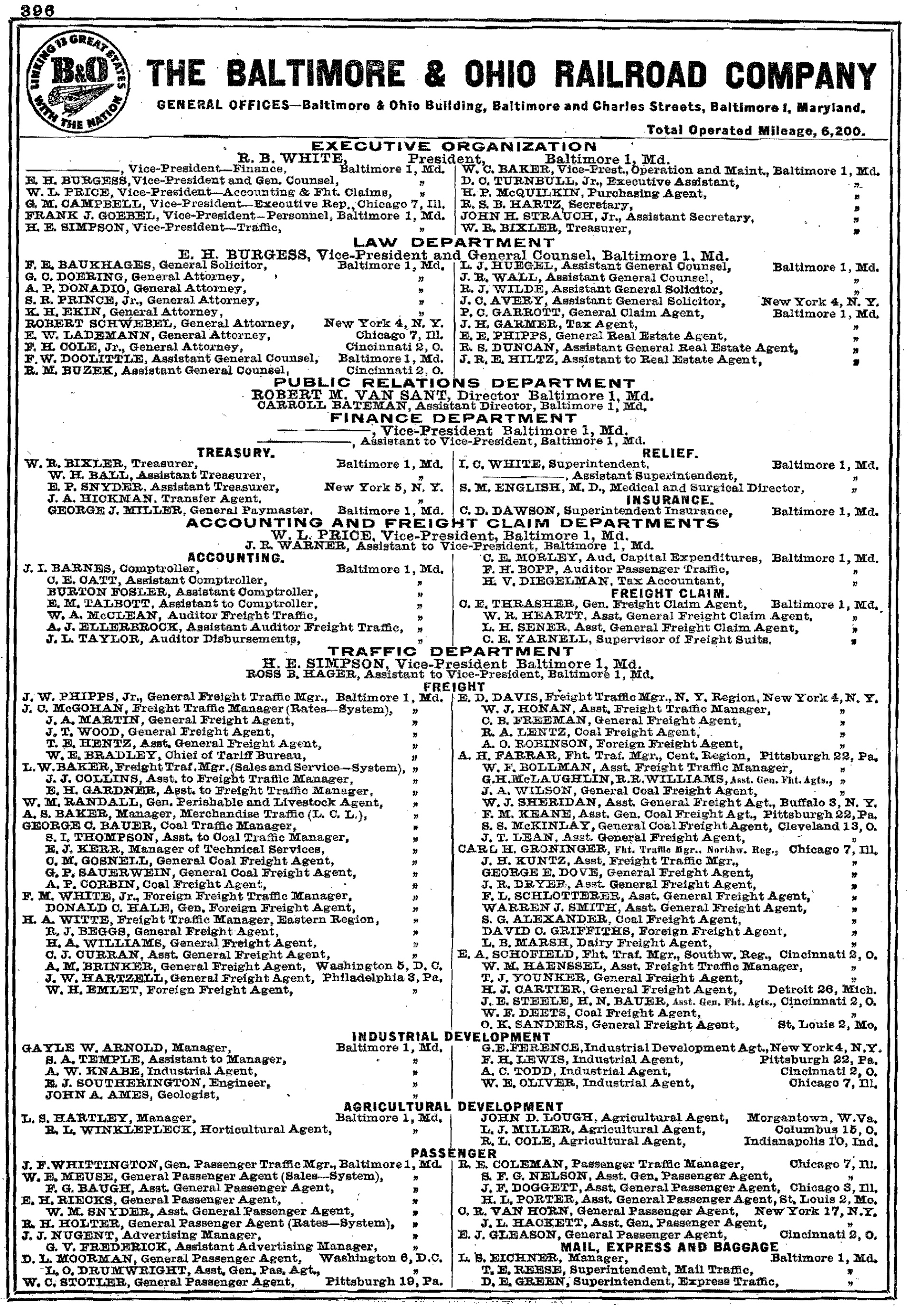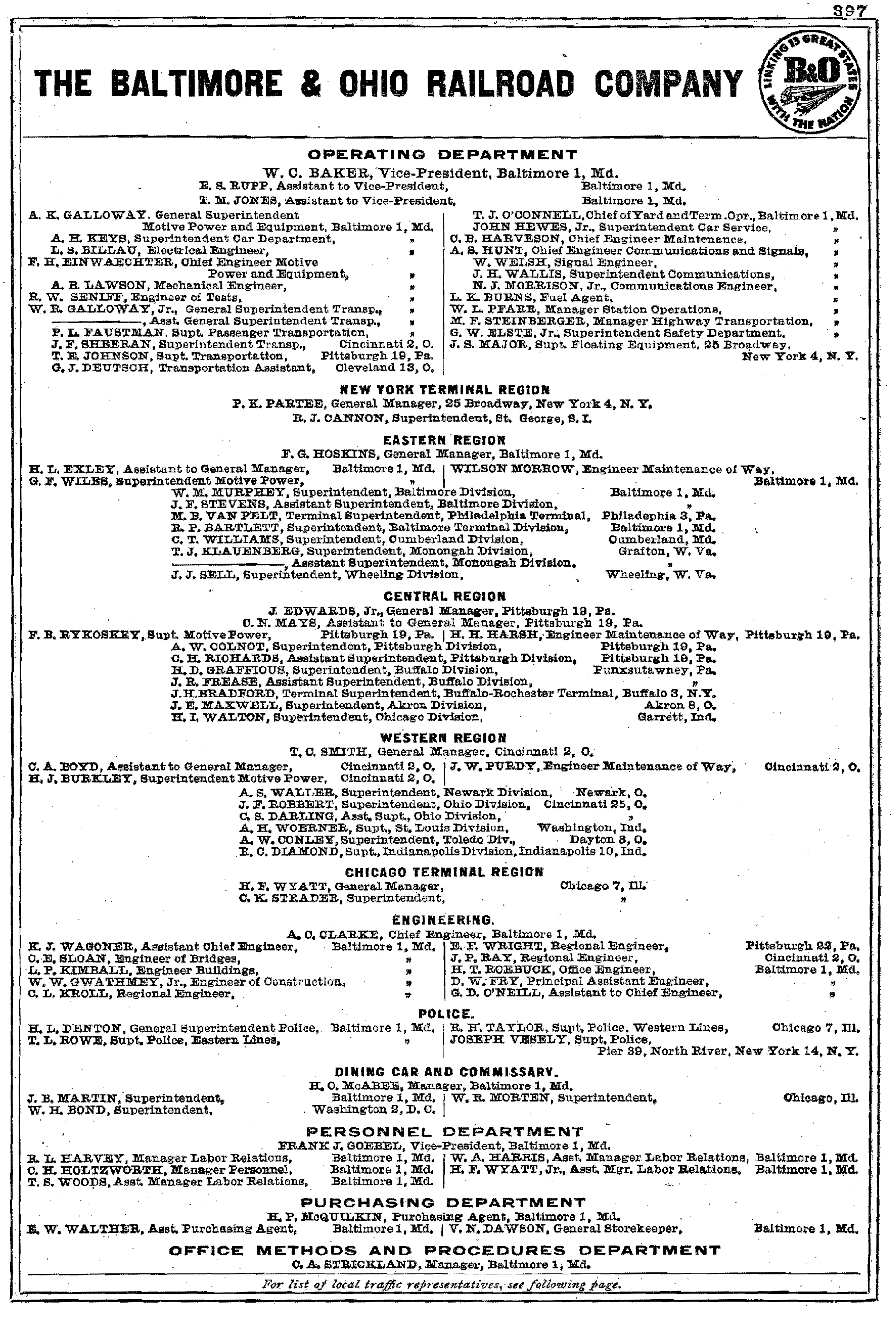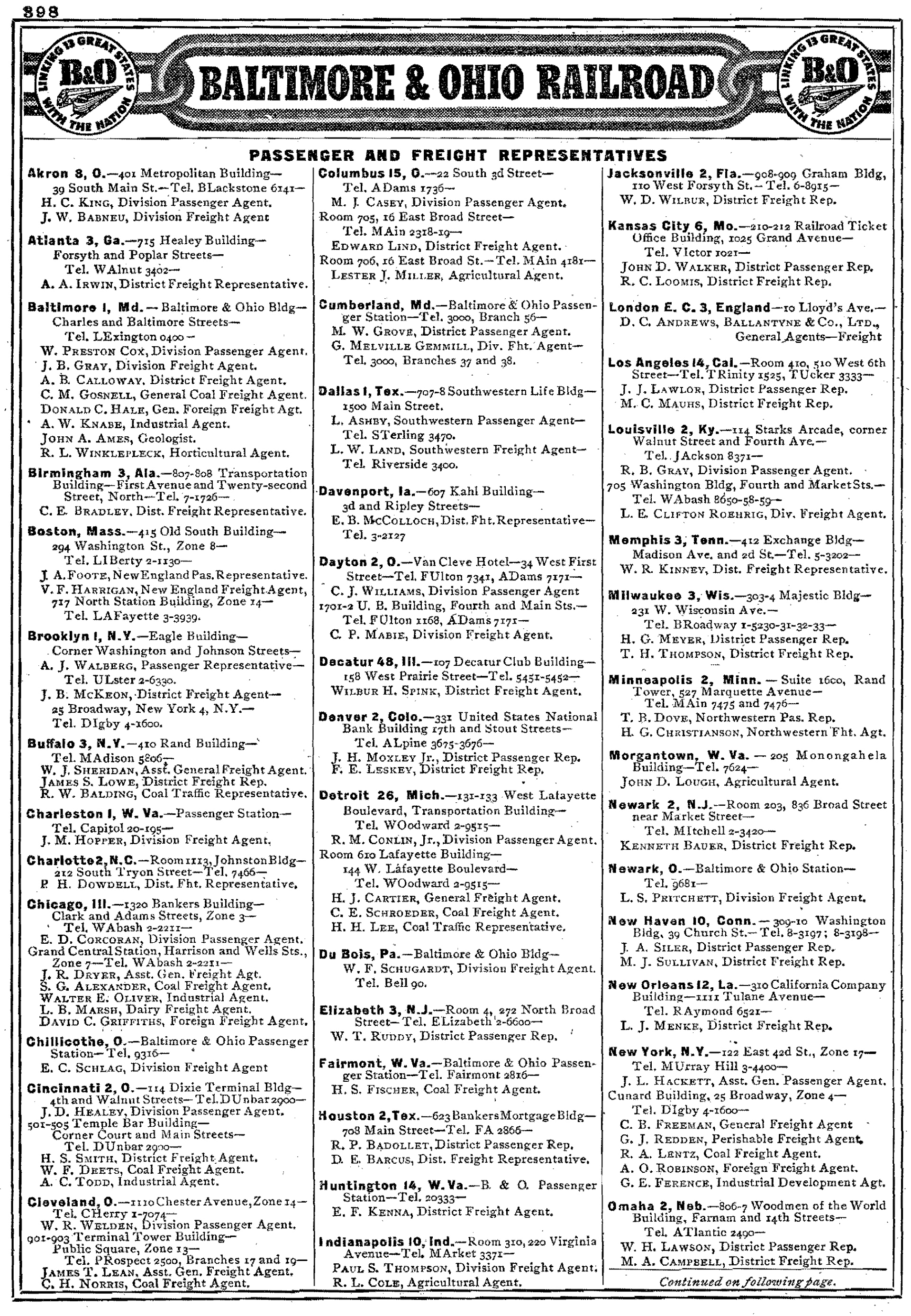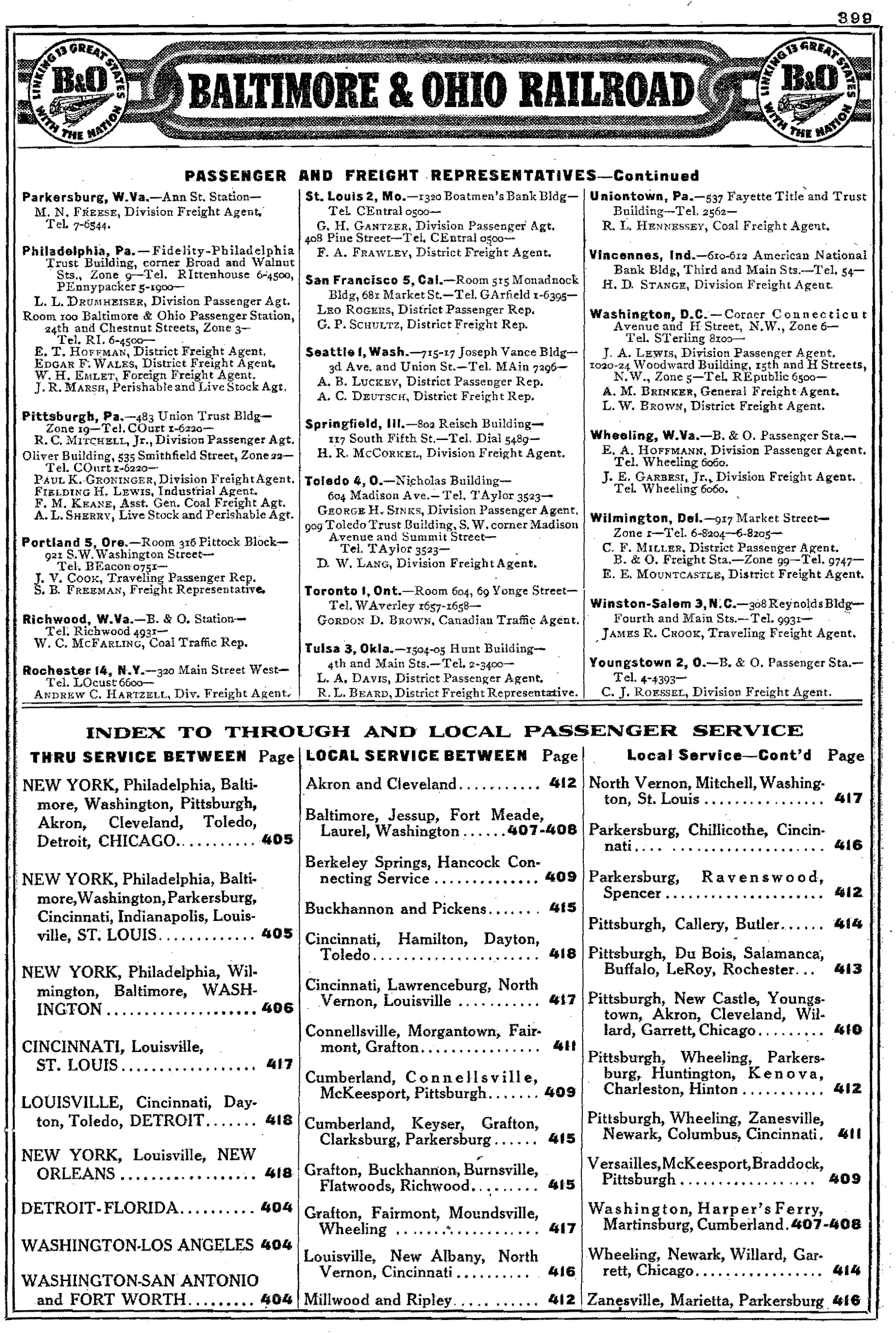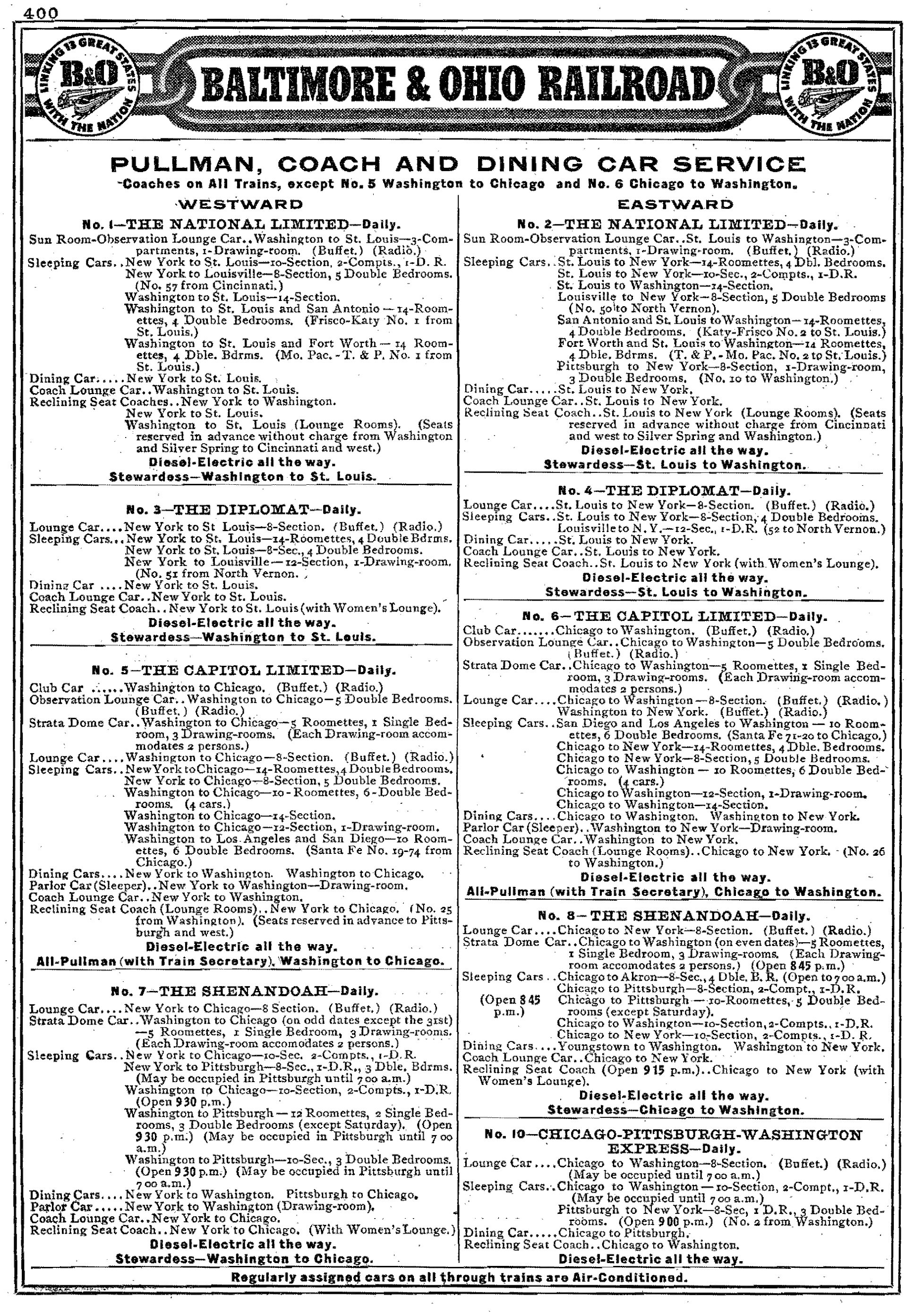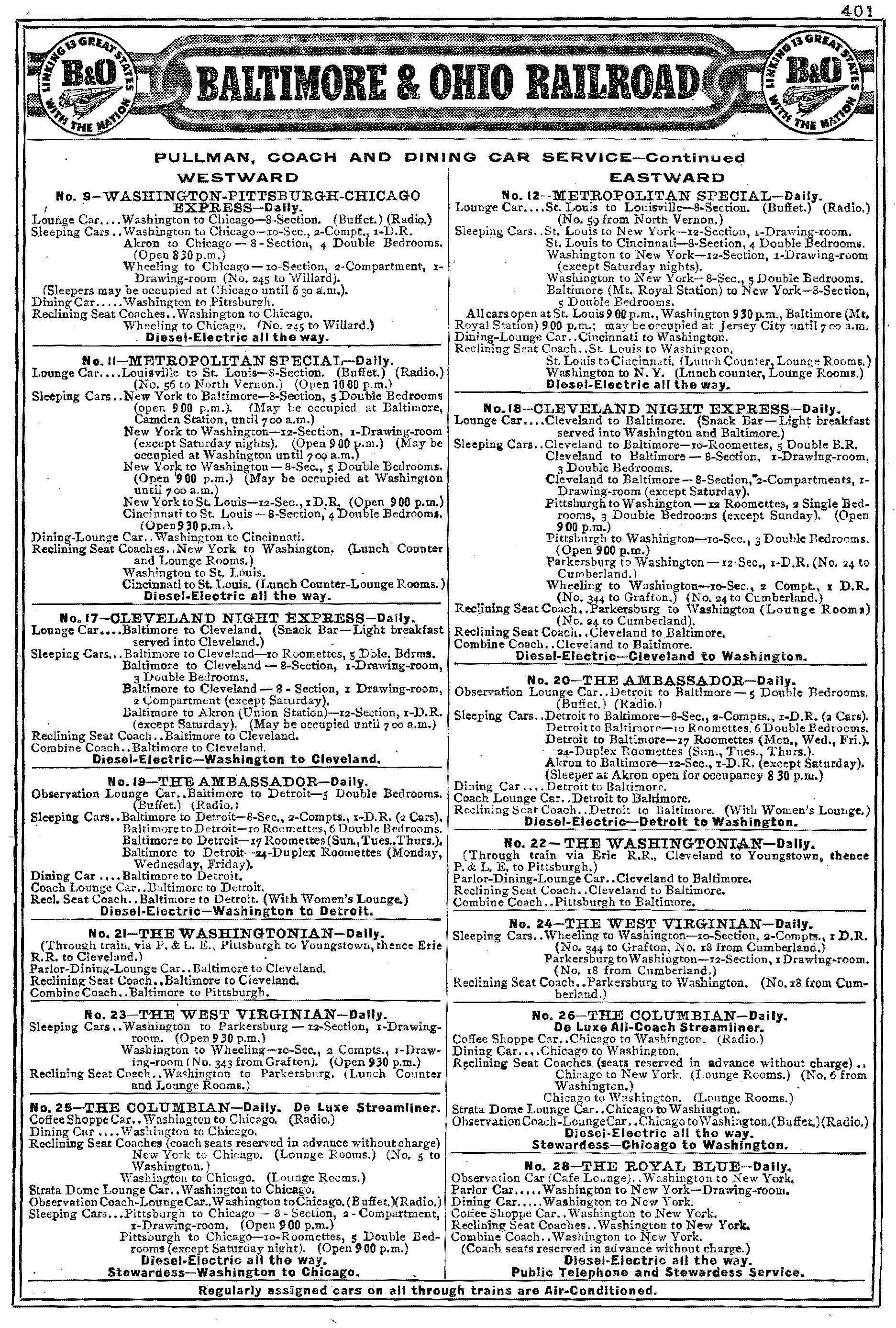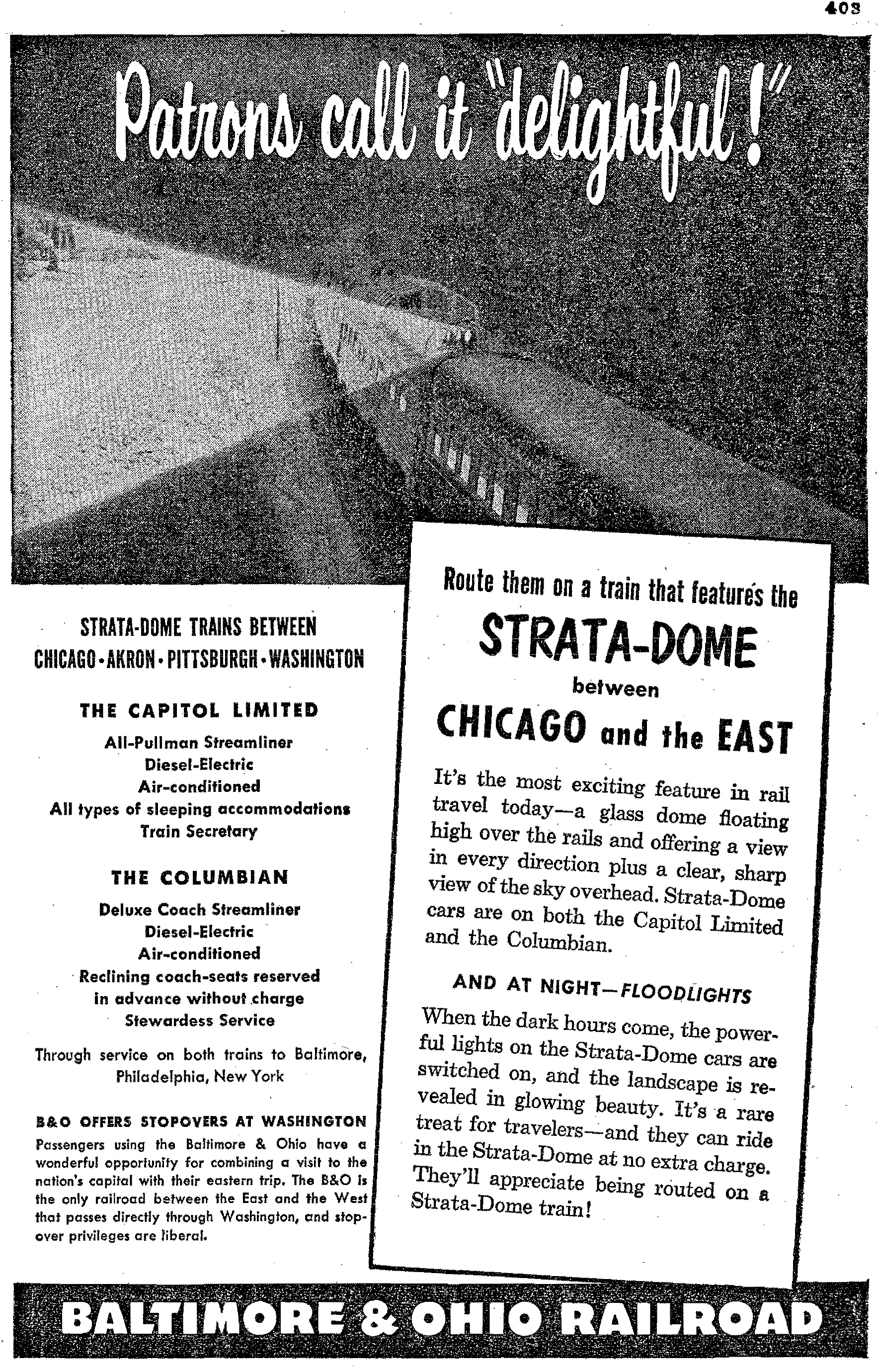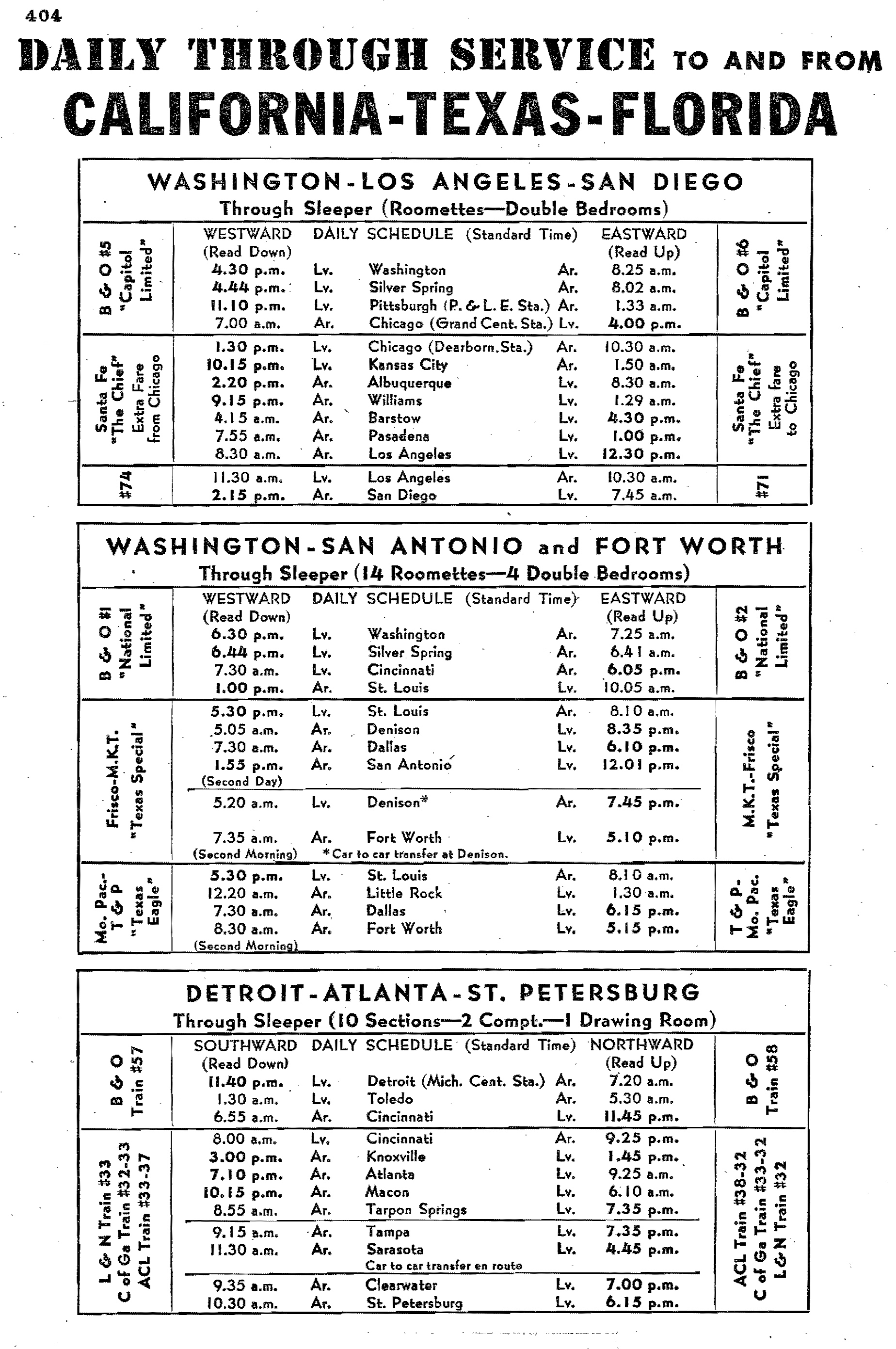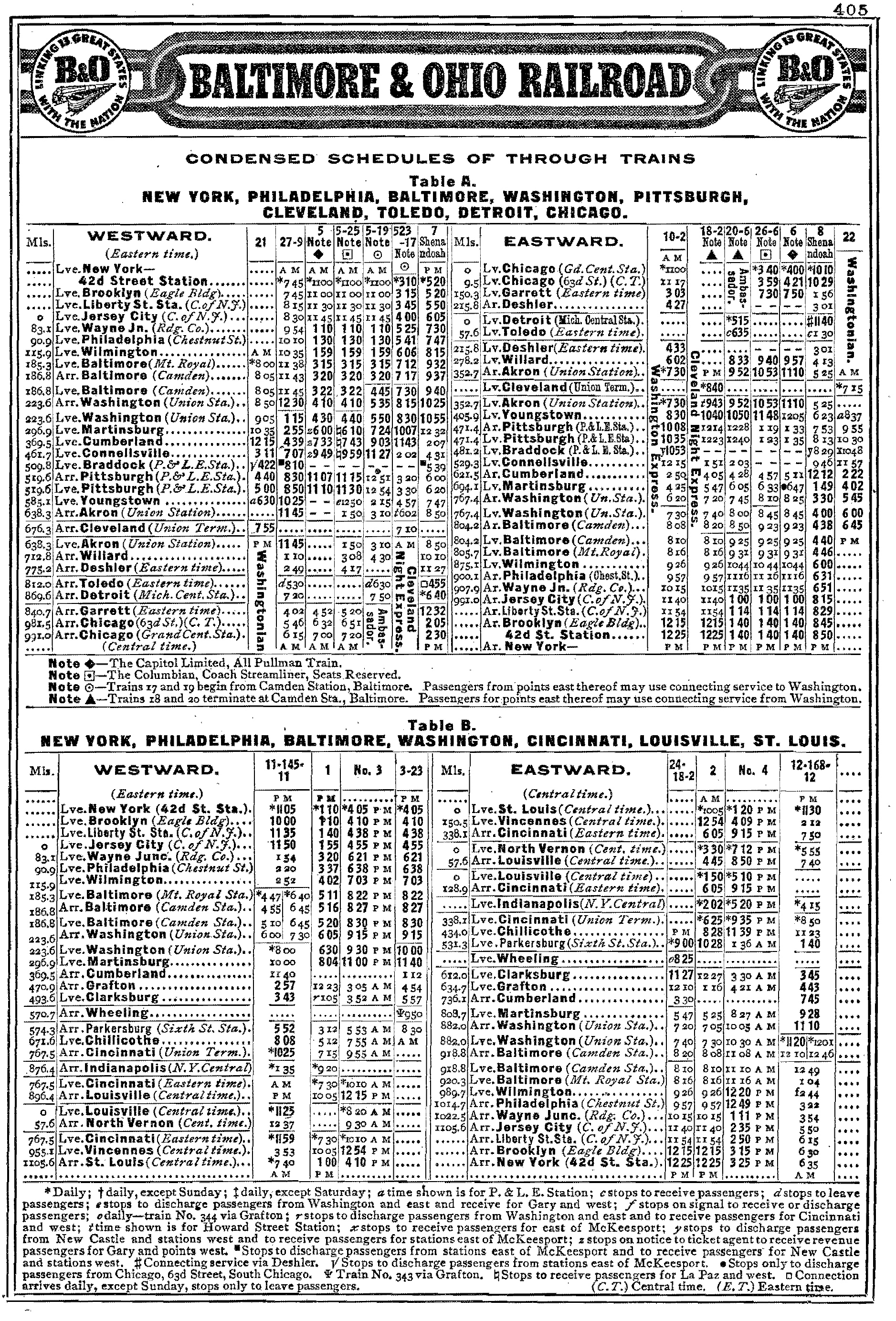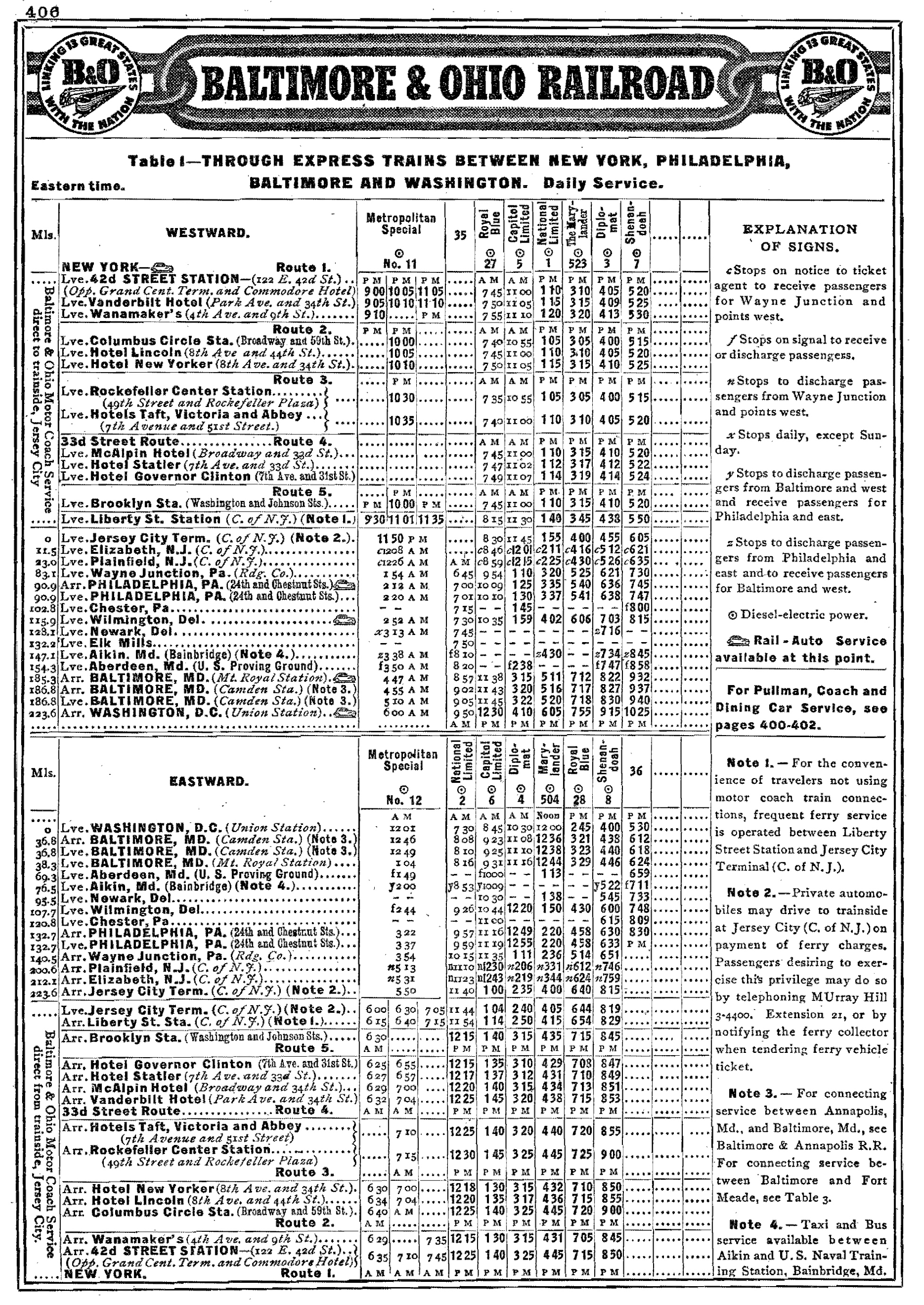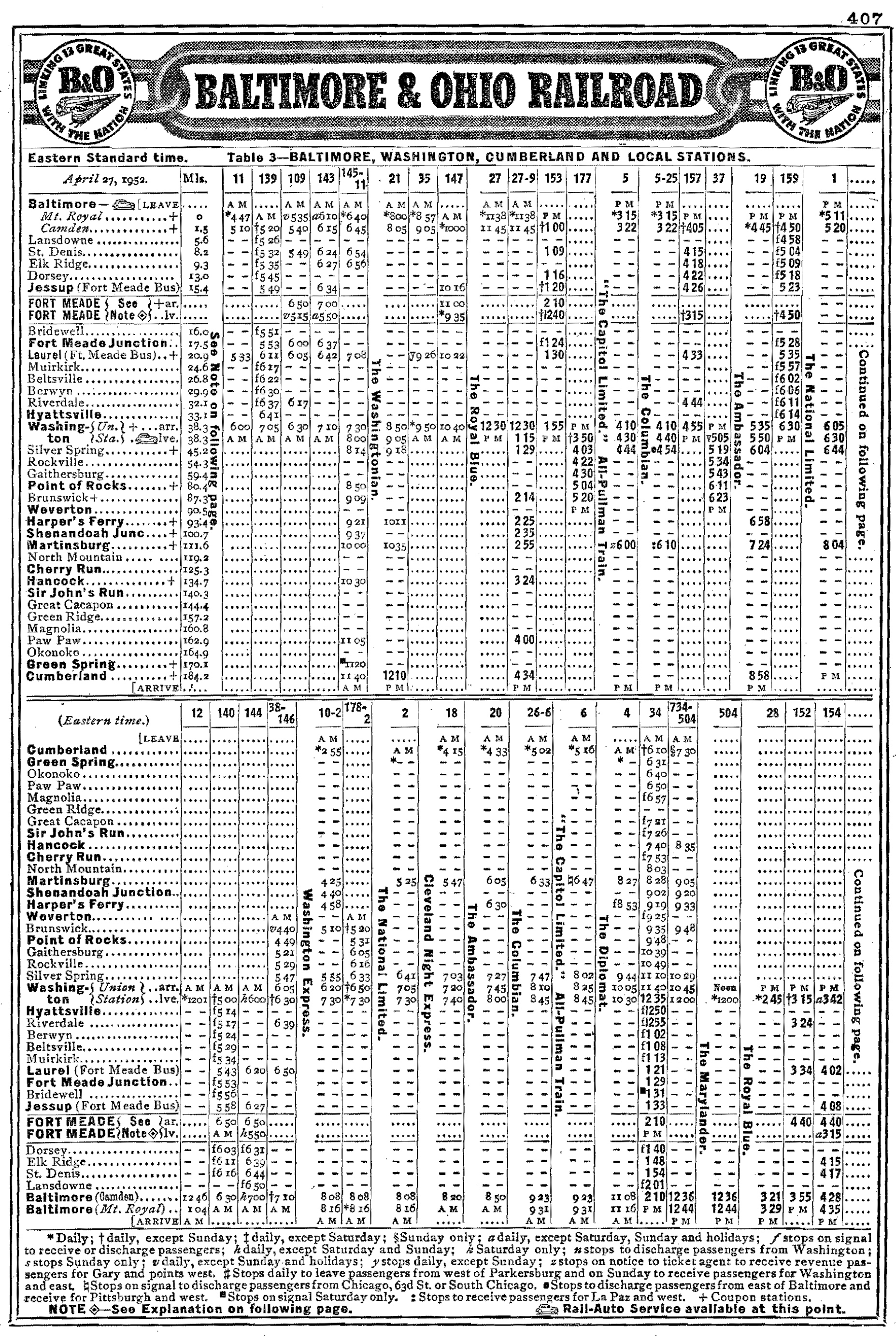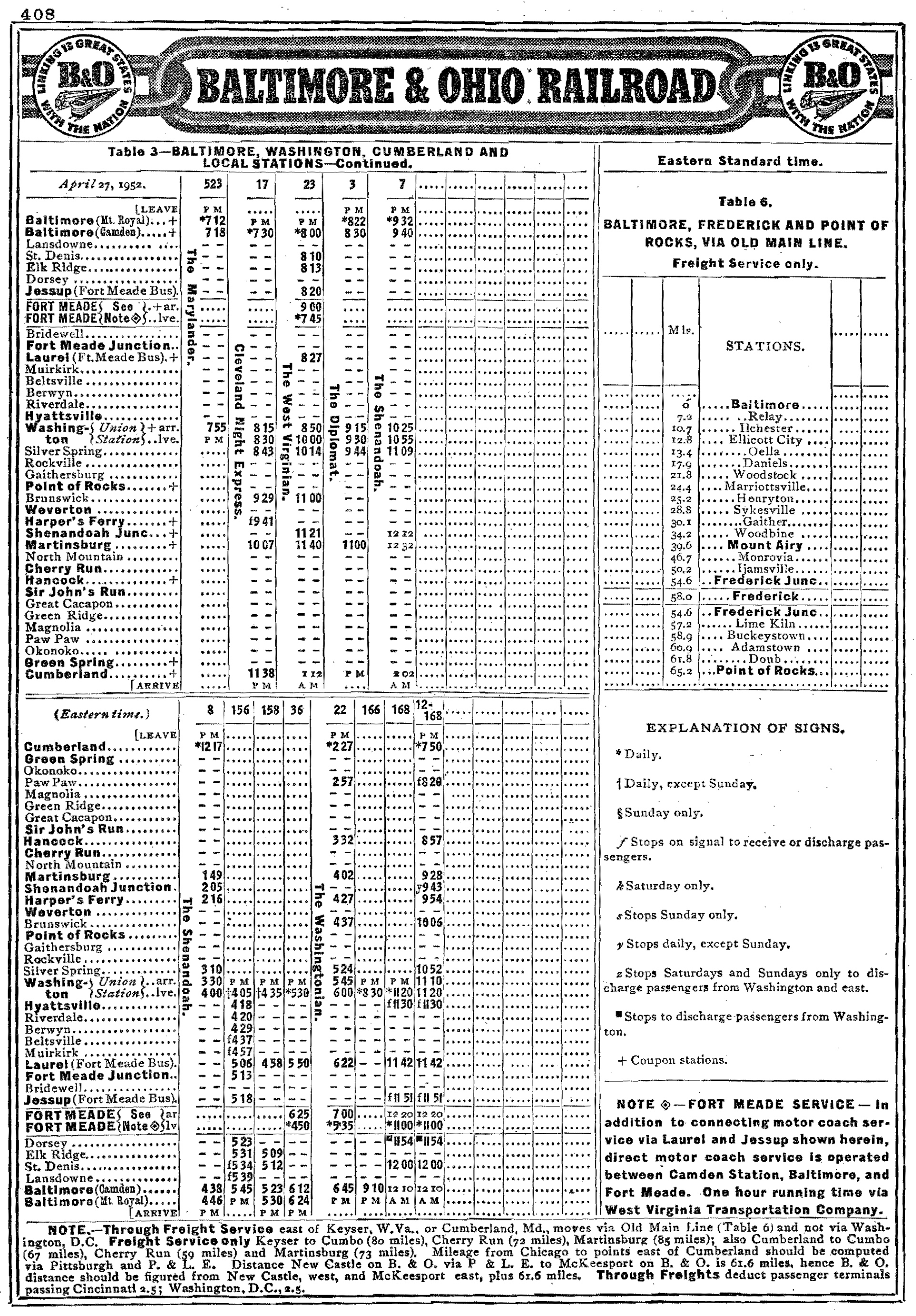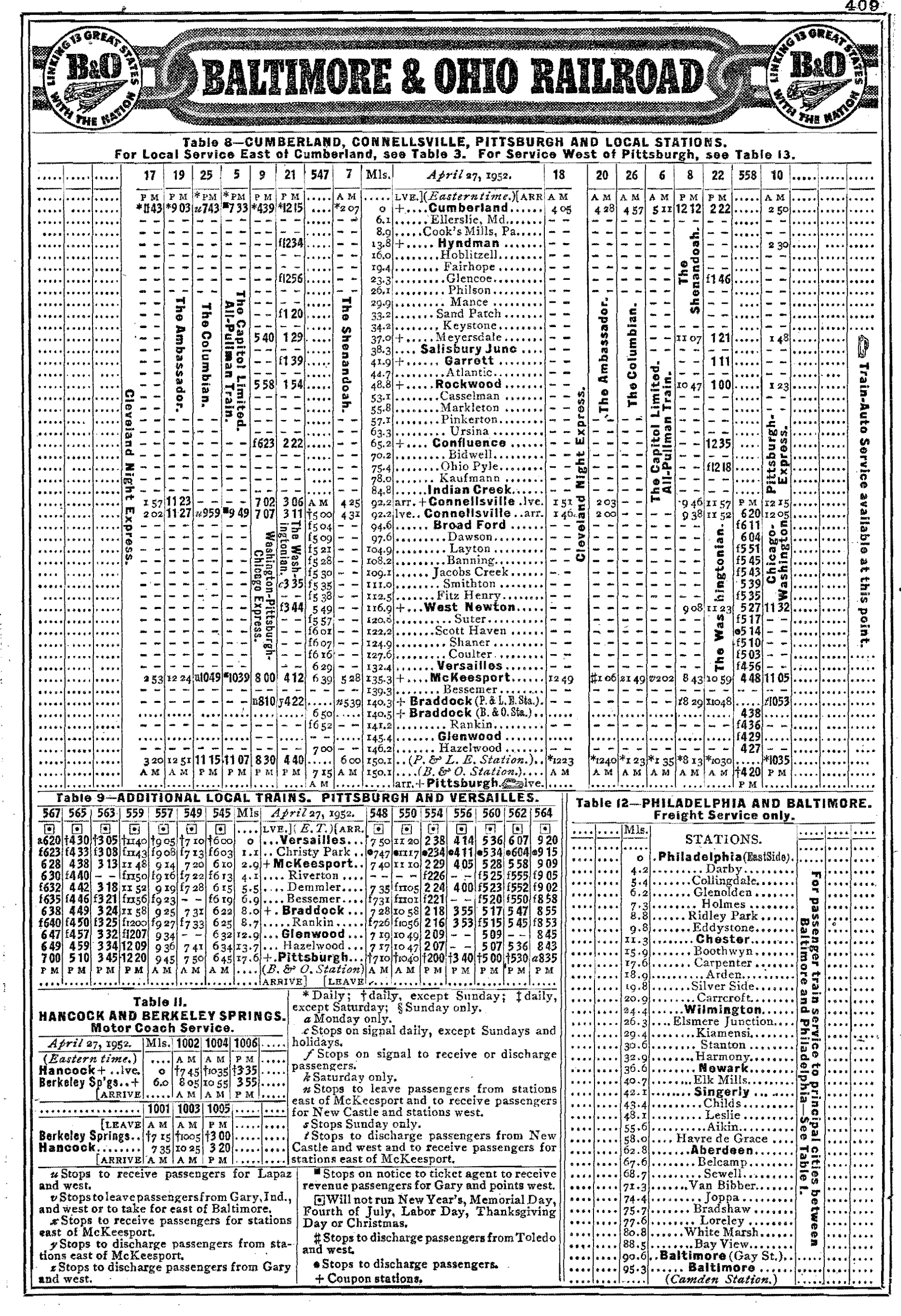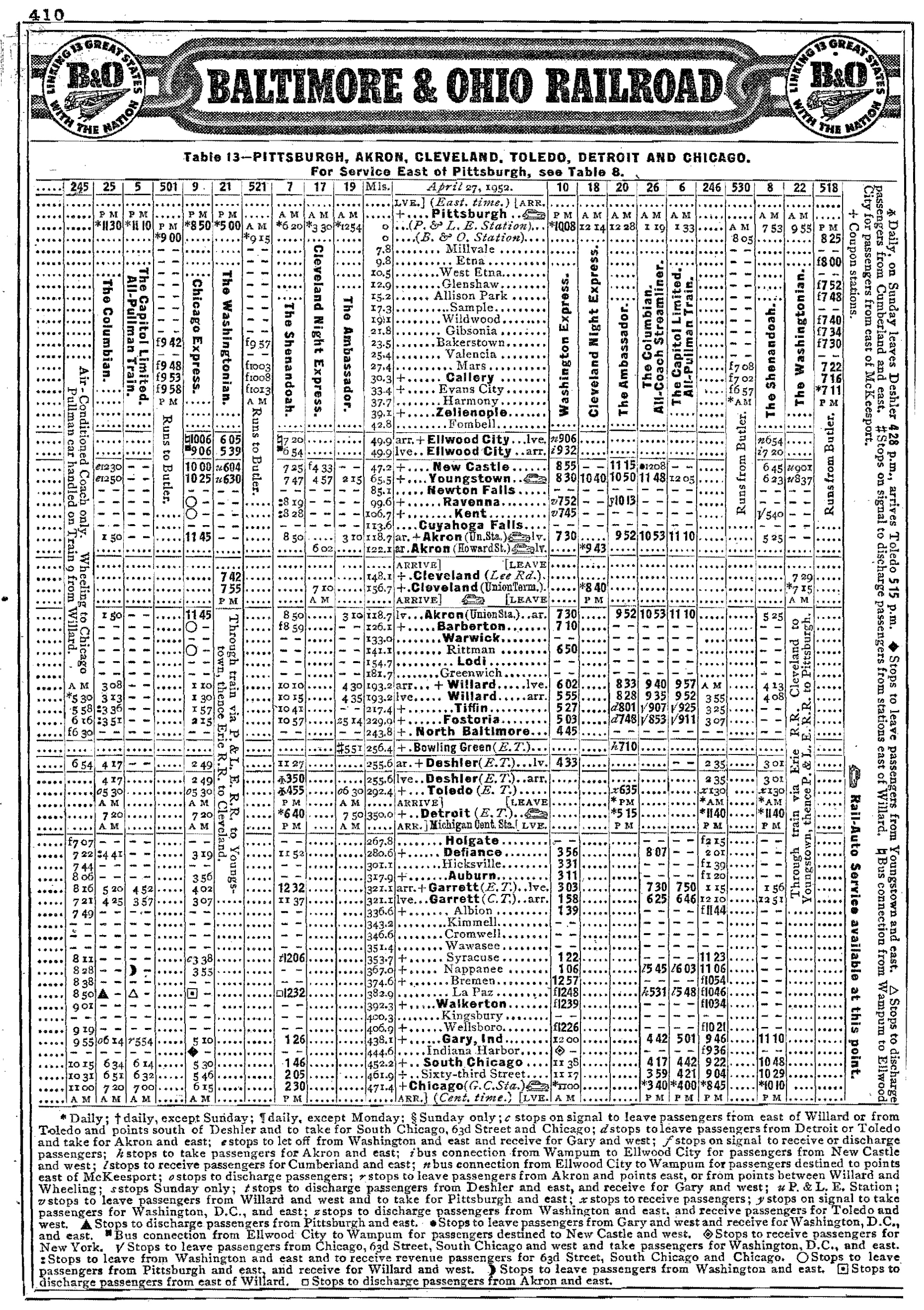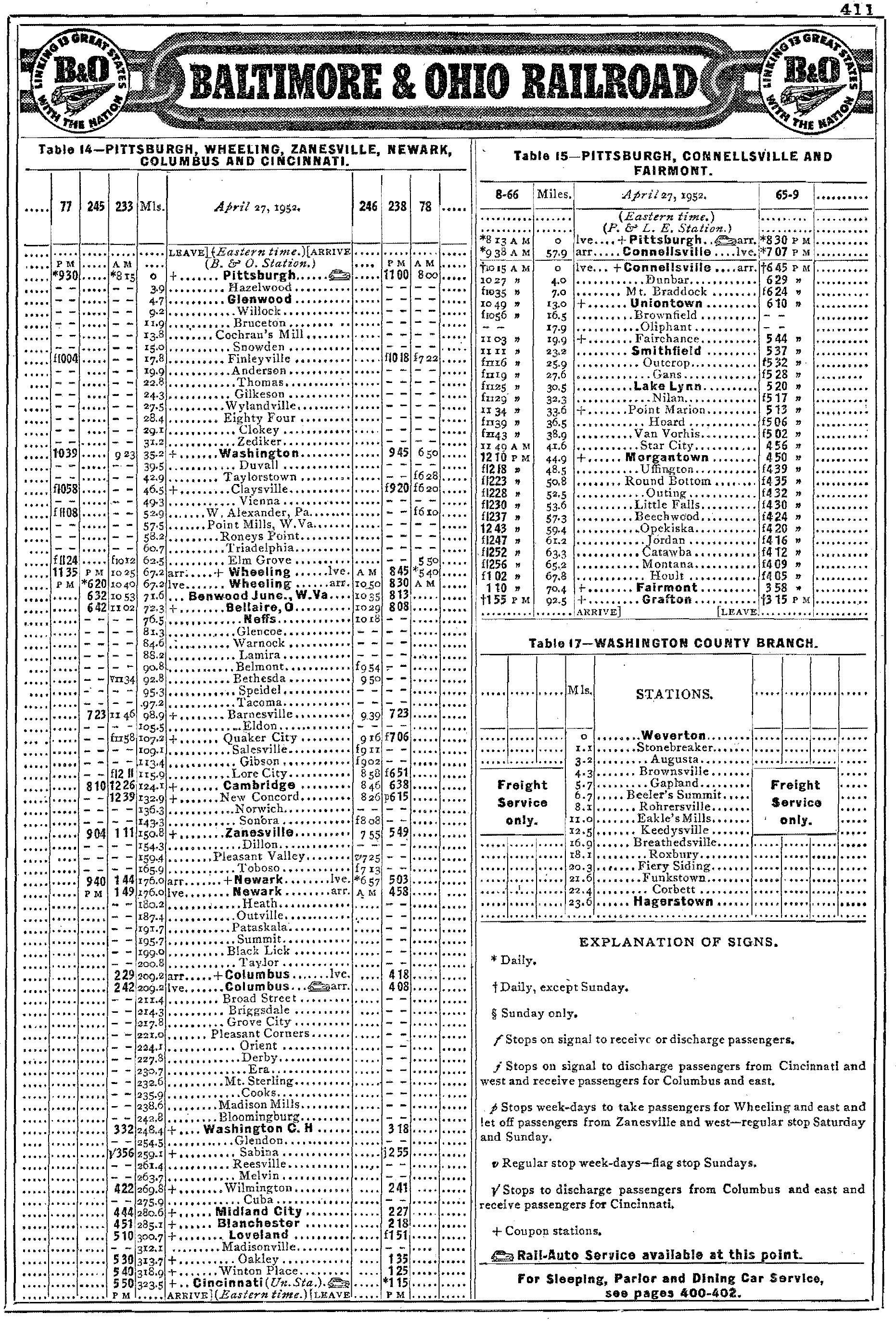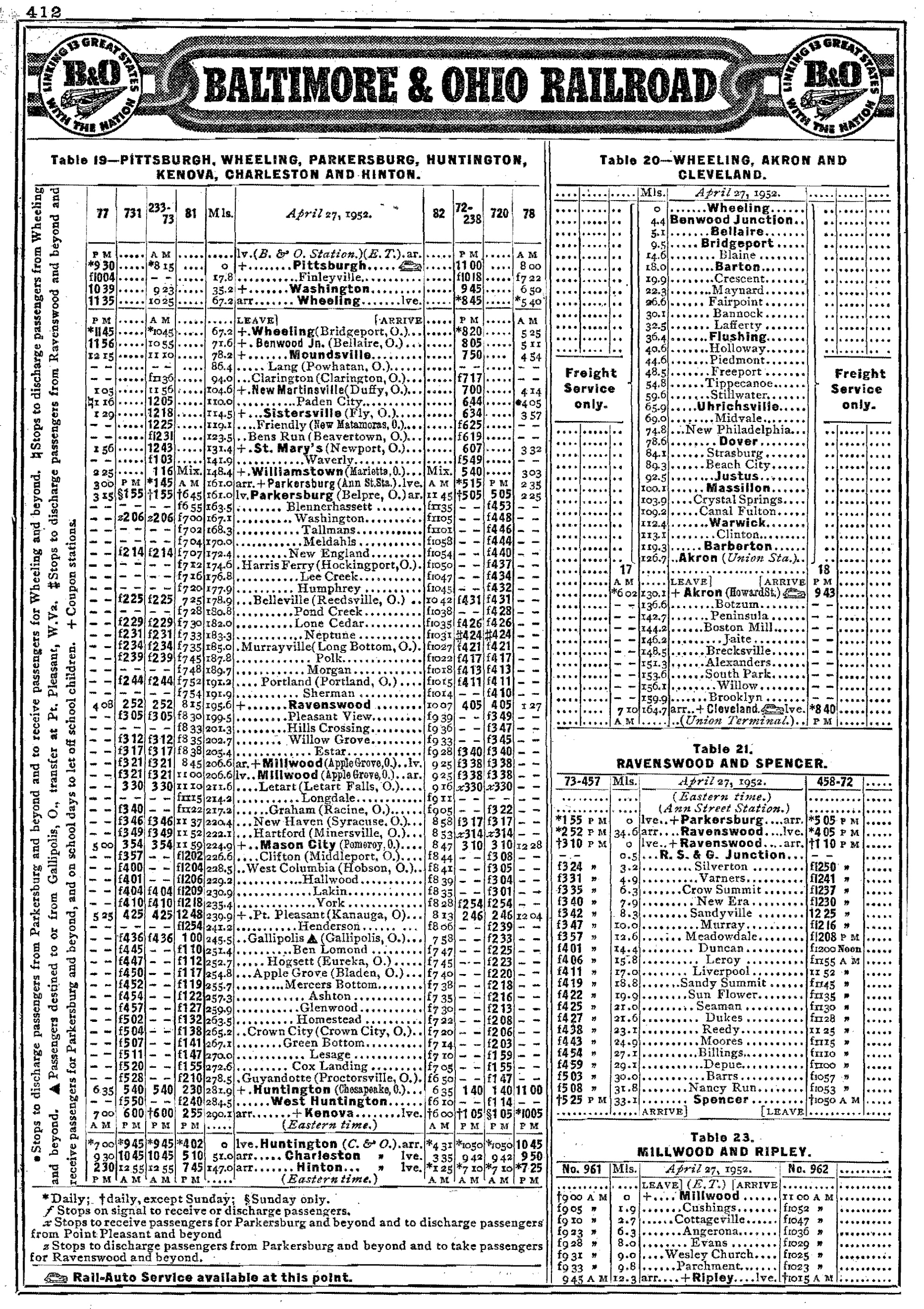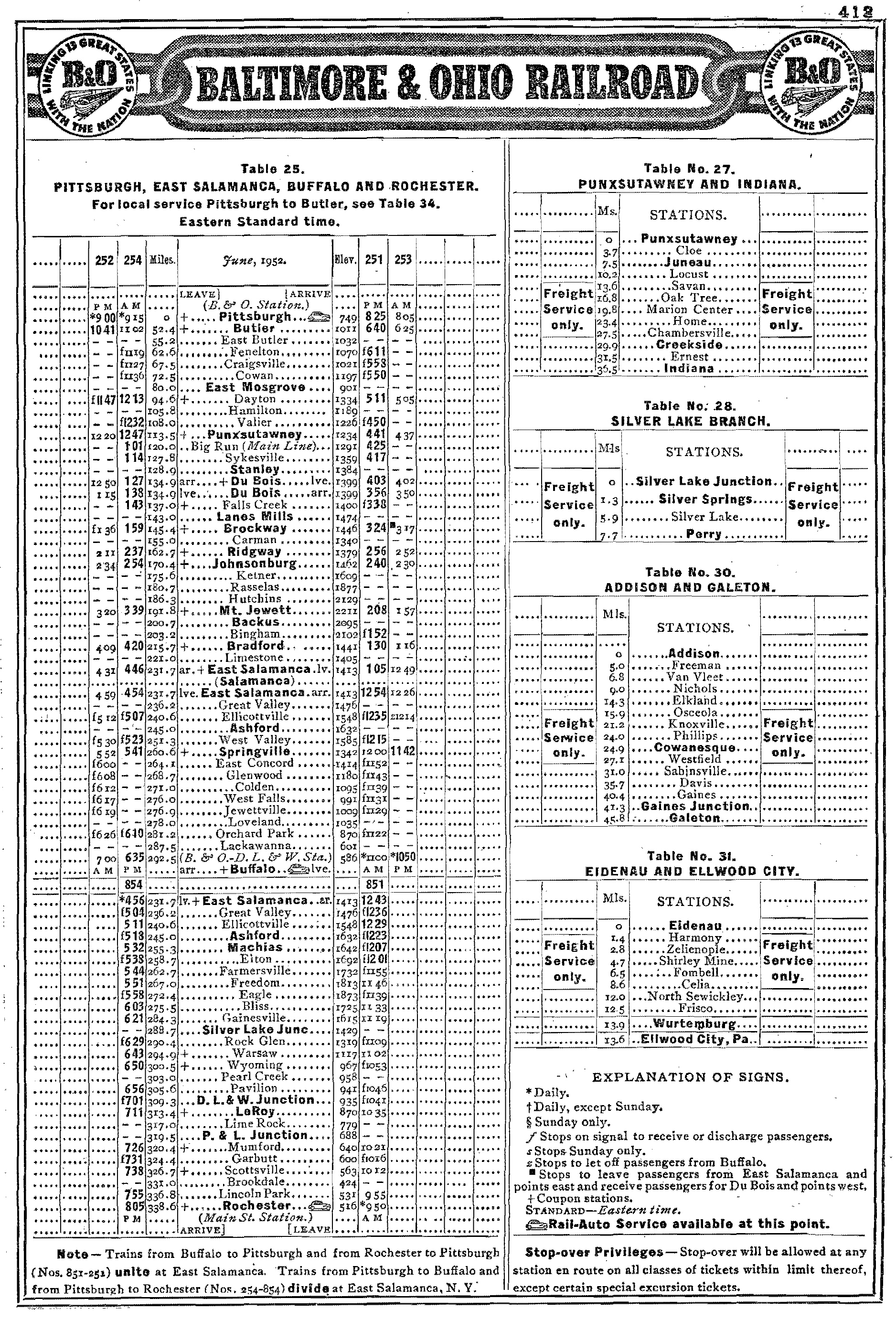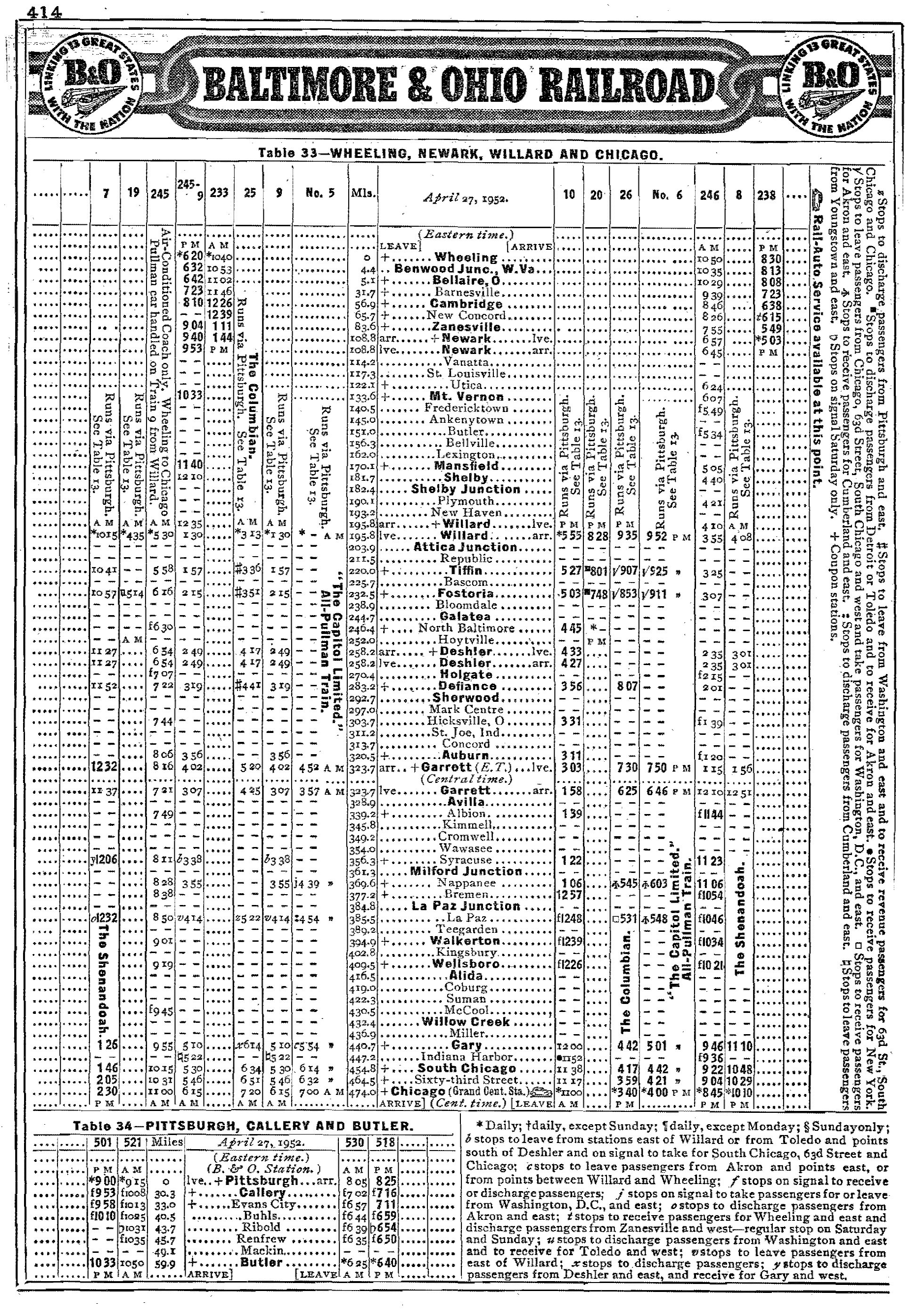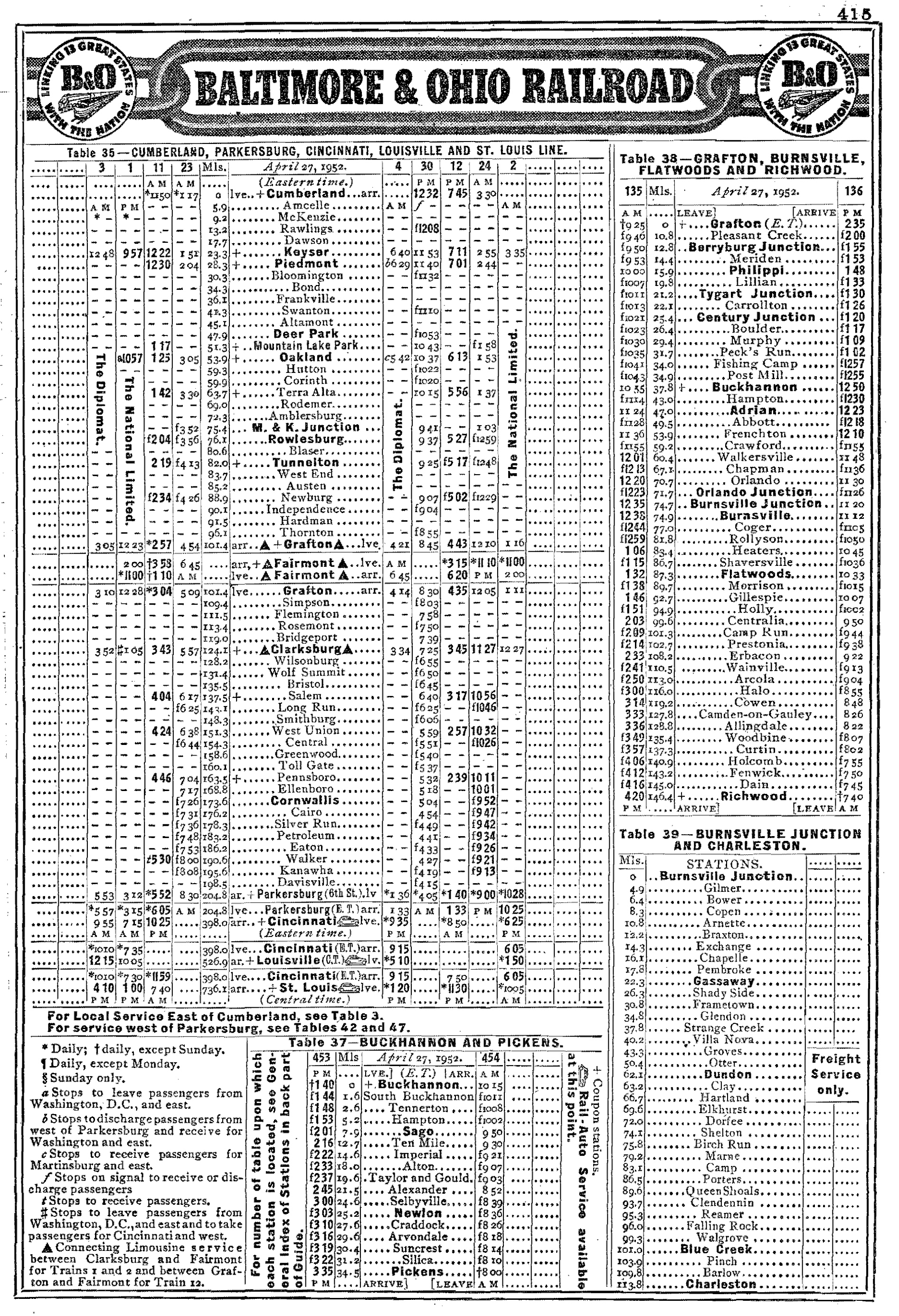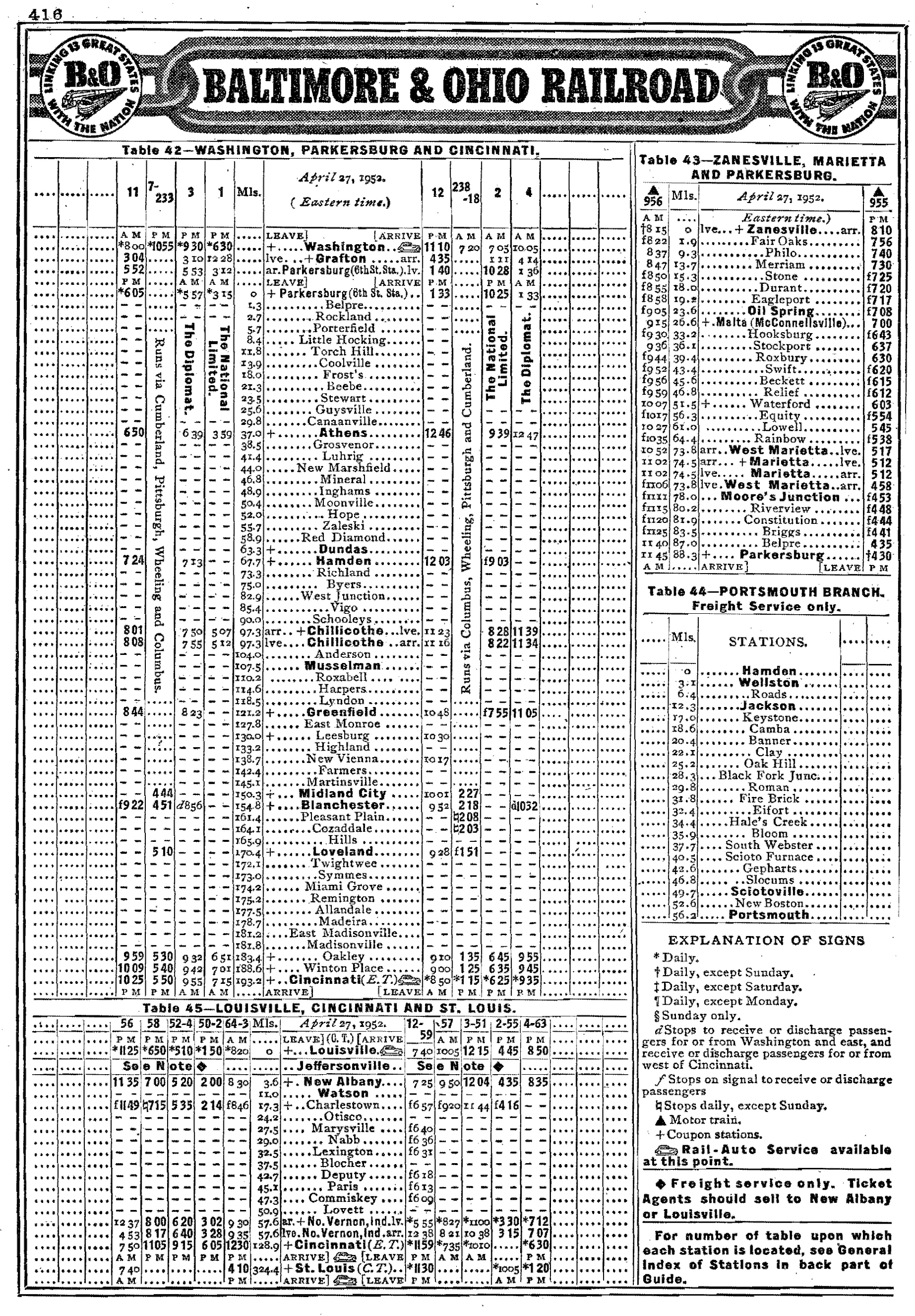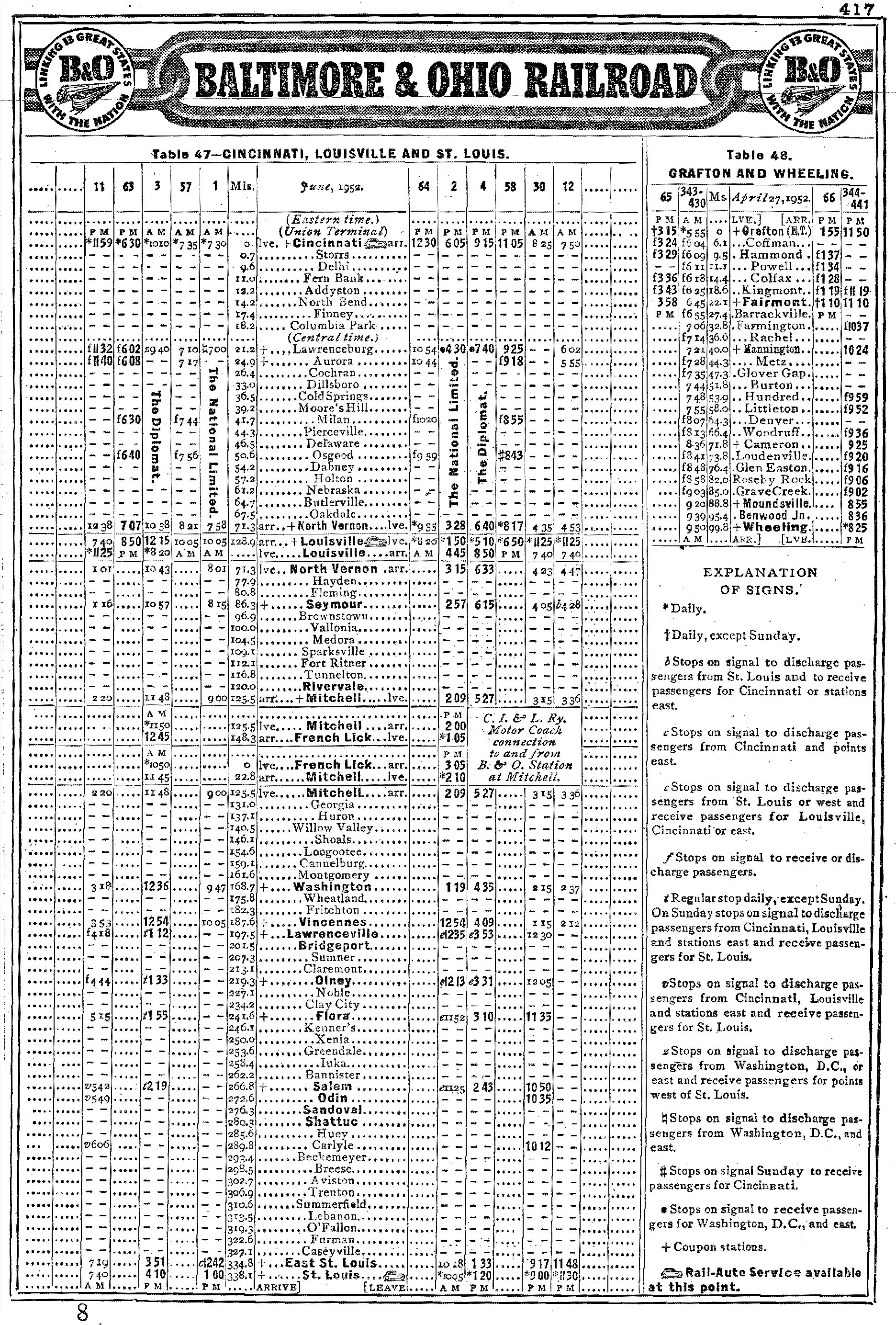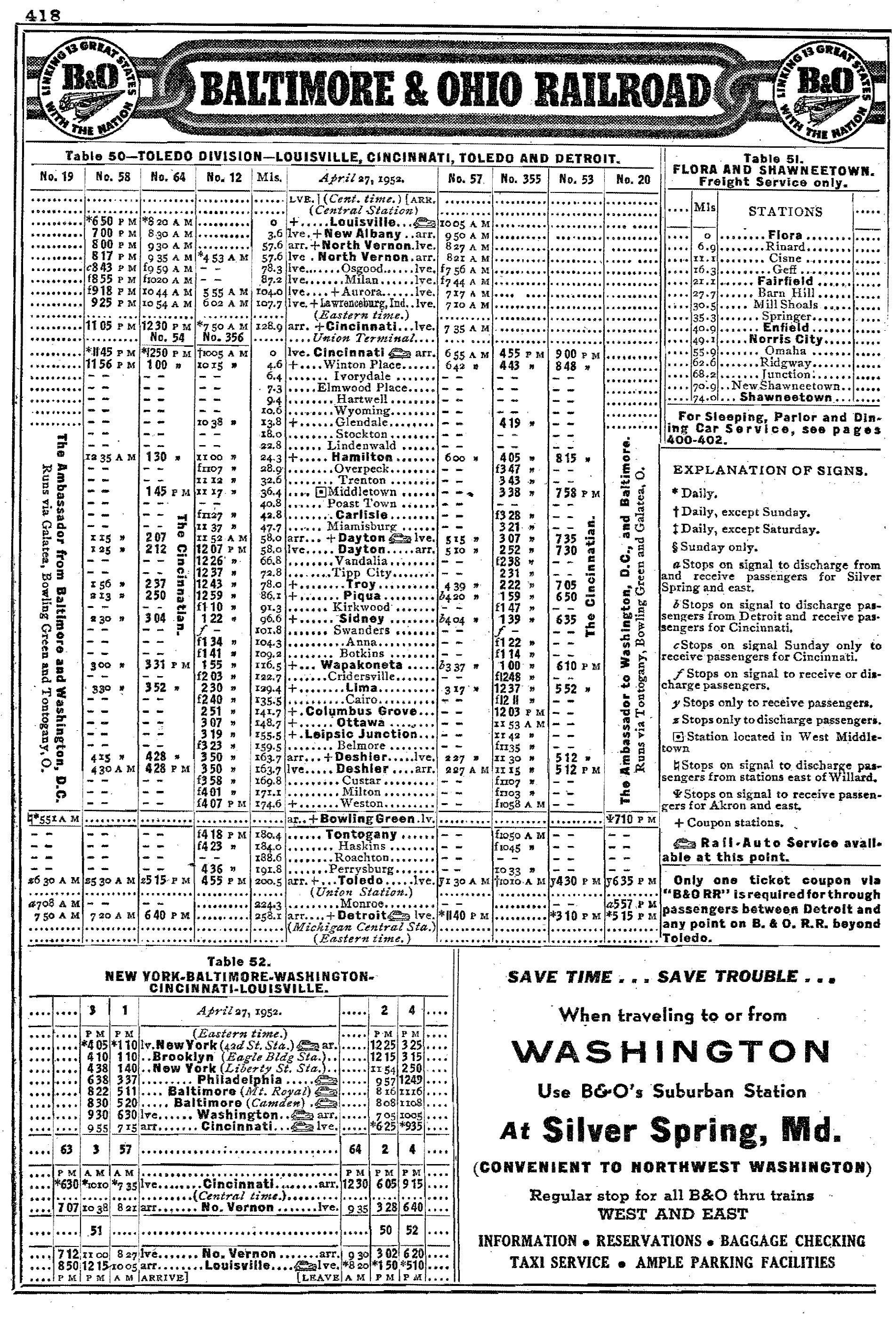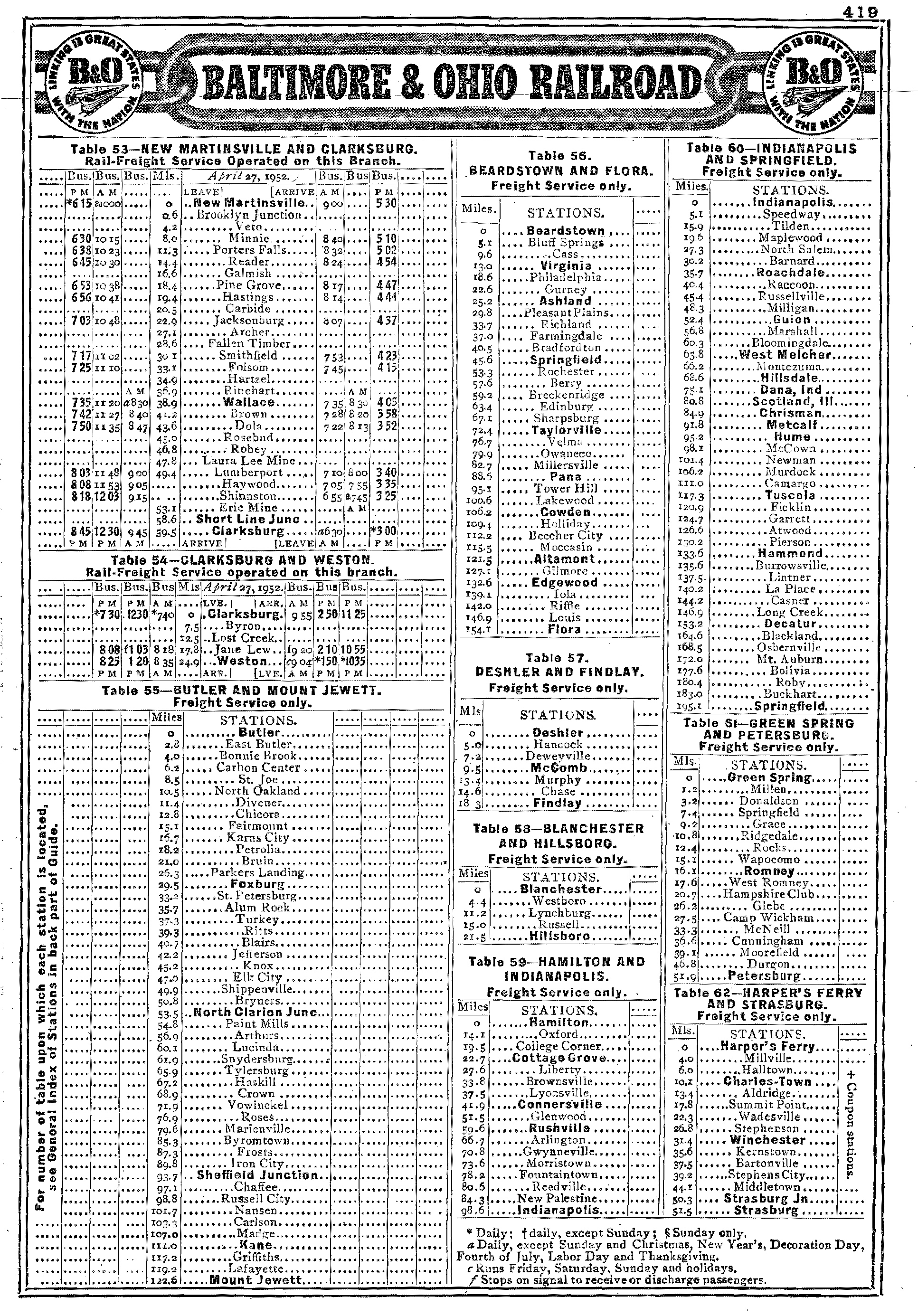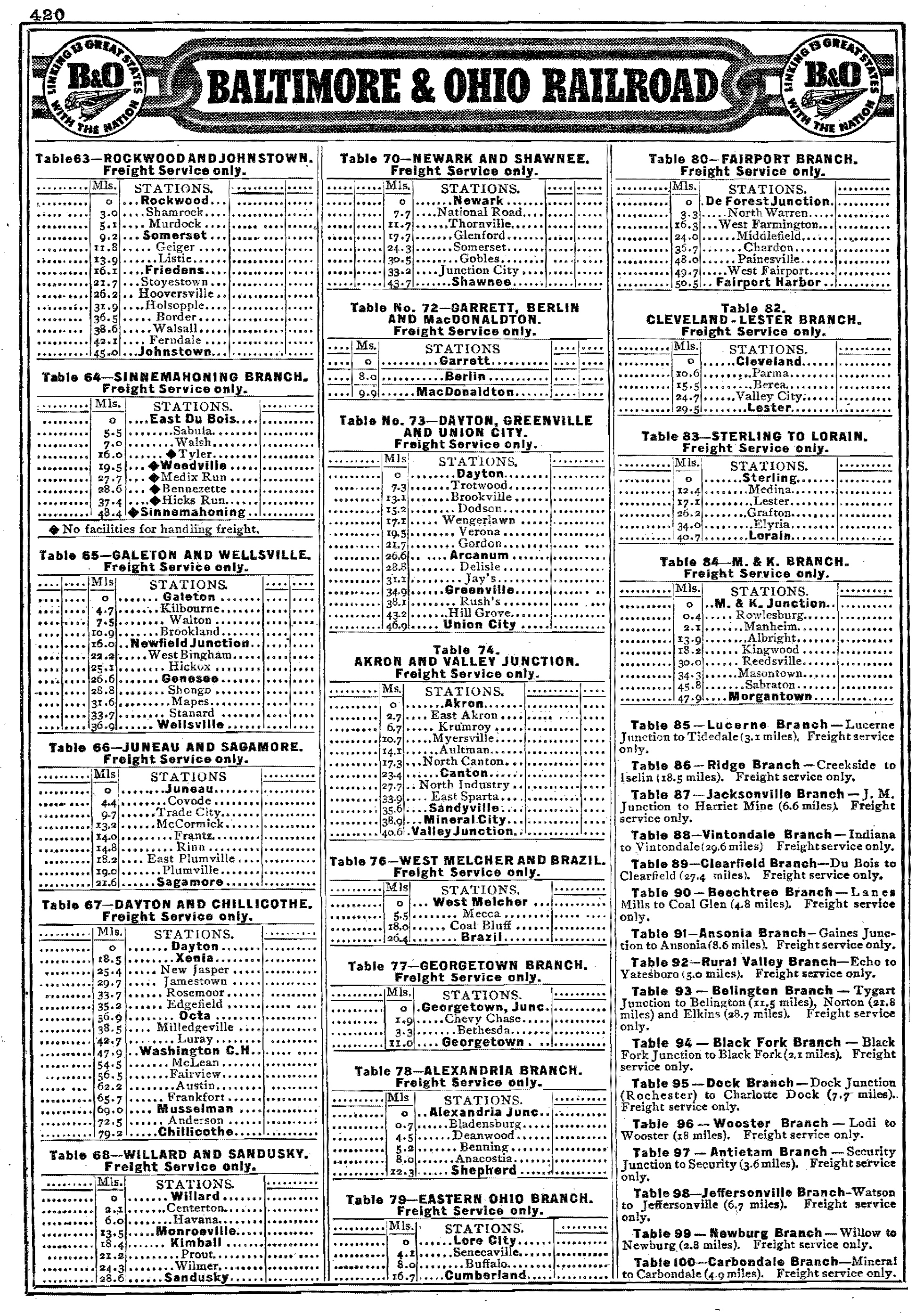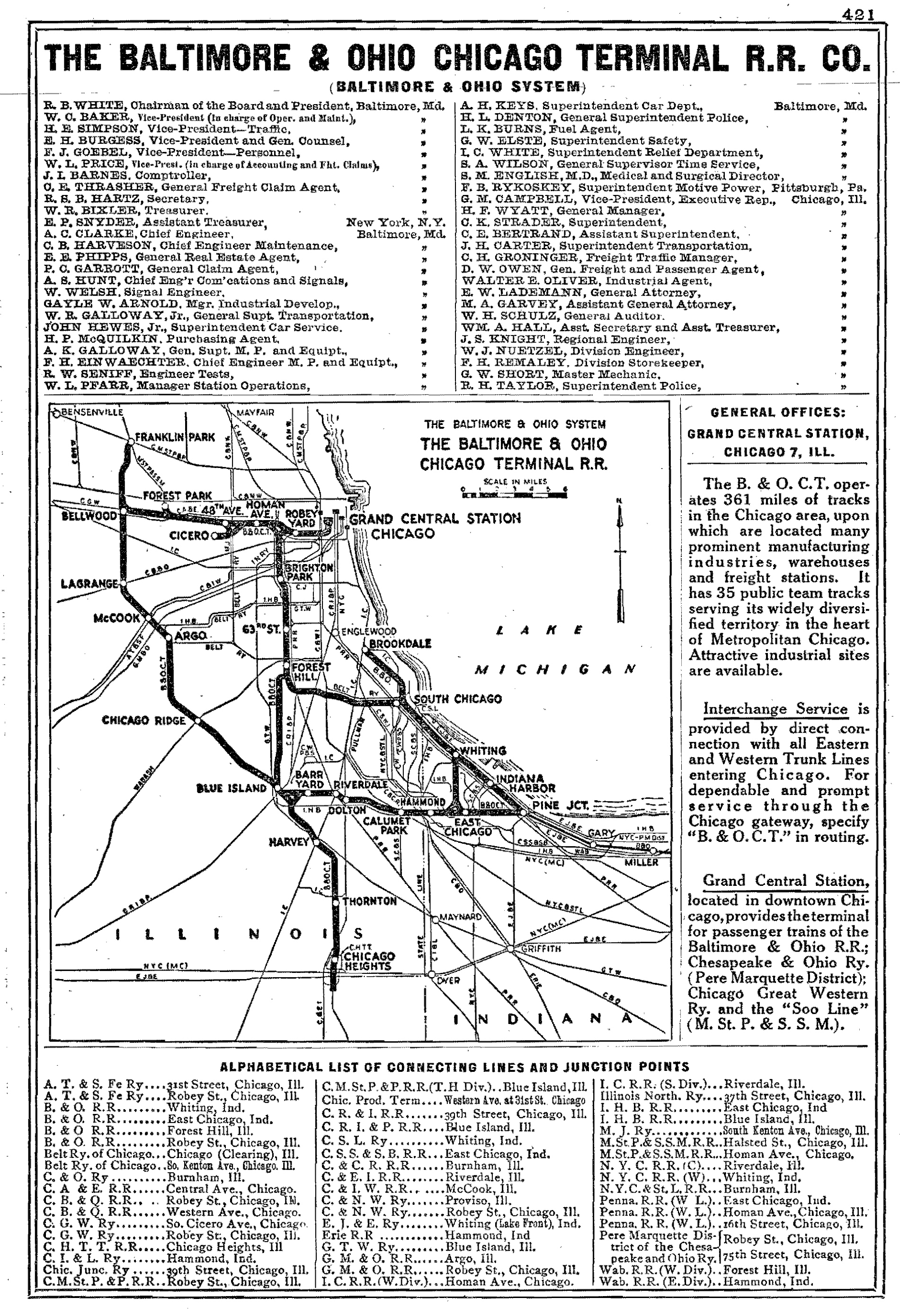Baltimore & Ohio (B&O) Timetables: 1952
Published: October 11, 2023
By: Adam Burns
As one of the three major eastern trunk lines the Baltimore & Ohio, operating or owning more than 6,500 routes miles in the 1950s from New York/Baltimore to Chicago/St. Louis, was prominently featured in "The Official Guide Of The Railways."
Its August, 1952 listing totaled 22 pages and, like all of the largest Class 1 systems at the time, featured company information at the forefront before listing the timetables. Names of all of the notable officers and those who headed areas such as public relations, traffic department, accounting, etc. are noted.
In addition to including all pertinent timetables for passenger services, including those served along obscure branches, the B&O also took the added step of featuring all freight branches.
While the company never listed actual times/dates when these secondary lines were served it did include all stations along the route as well as route mileage. This information is handy today for anyone researching these aspects of the railroad.
Official Guide (8/1952)
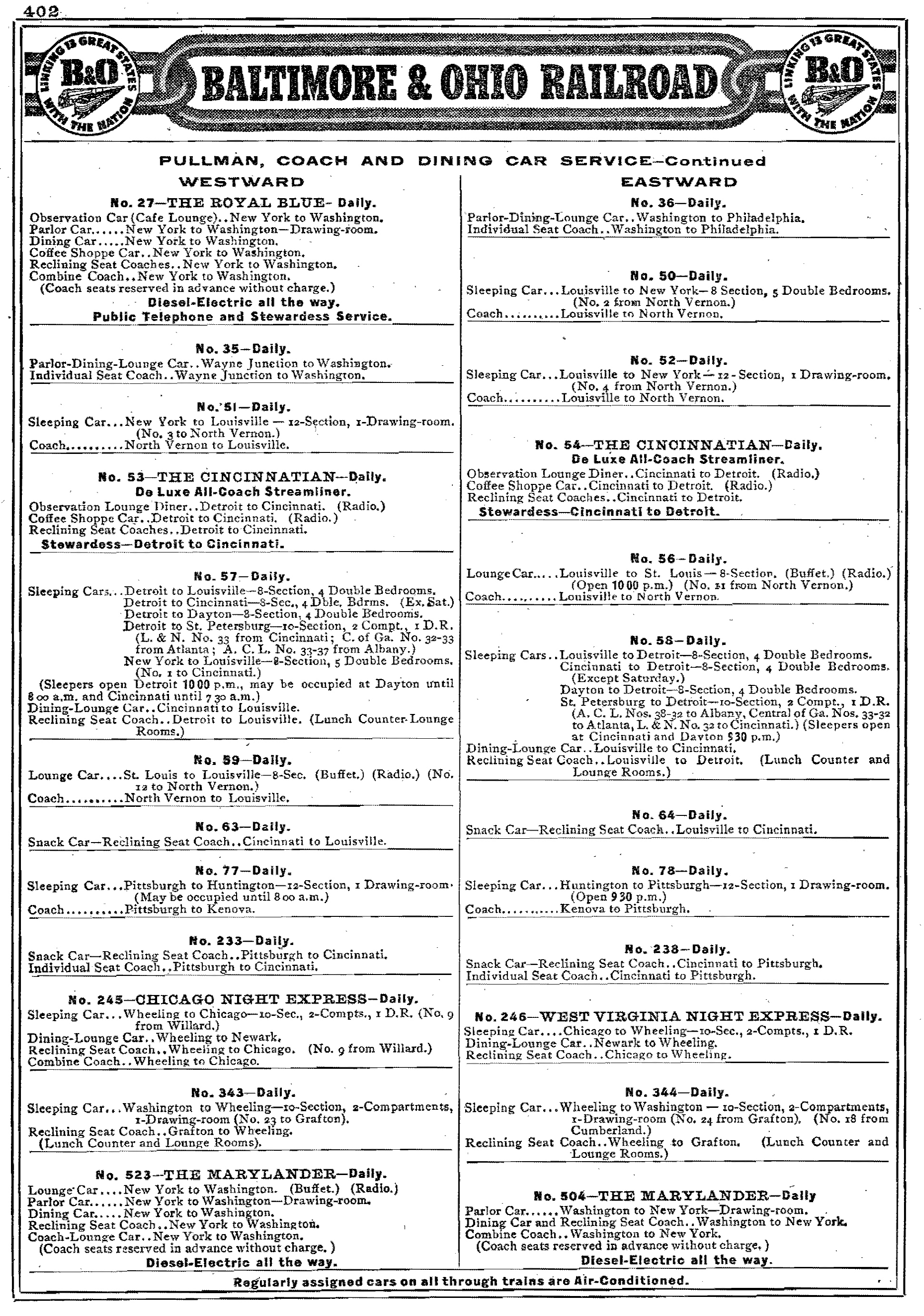
History
The Baltimore and Ohio Railroad (B&O) was the first common carrier and Class I railroad in the U.S, chartered in 1827. It was established to transport freight and passengers from Baltimore's port to a suitable western terminus.
The railroad played a significant role in the development of the American transportation system in the 19th and 20th centuries. It was absorbed into the Chesapeake and Ohio Railway in 1963, which later merged into CSX Transportation.
The B&O, which emerged around the dawn of the 19th century in 1827, is significant for the role it played in shaping America's railroad industry. Incorporated by a team of Baltimore-based merchants, it served as America's first fully fledged commercial railroad, opening avenues for a revolutionary change in transportation, commerce, and communication.
In its long span of service which lasted nearly 160 years, the B&O served a number of states across America’s mid-Atlantic and Midwest regions. It entrenched itself in Maryland, Virginia, West Virginia, Pennsylvania, Ohio, Indiana, Illinois, and extending as far as Missouri.
Over its lifetime, the B&O covered an extensive network of rail trackage. At its peak, it extended over a distance of approximately 5,580 miles, thereby playing a critical part in connecting numerous cities and towns across various states.
The primary purpose of the Baltimore and Ohio Railroad was to reaffirm Baltimore’s competitiveness with emerging superpower cities like New York and Philadelphia as they embraced the Erie Canal. B&O was designed to offer a viable, faster transportation alternative, primarily for moving freight and passengers, thus facilitating regional economic growth.
In 1962, the Chesapeake and Ohio Railway acquired a substantial share of the Baltimore and Ohio Railroad, thereby marking the start of a merger journey. Then, in 1987, formal consolidation took place under a single entity known as the CSX Transportation network.
The official groundbreaking ceremony of the B&O happened on Independence Day of 1828, with Charles Carroll, the last surviving signer of the Declaration of Independence, laying the cornerstone. B&O’s initial track was a 13-mile stretch from Baltimore to Ellicott's Mills, Maryland.
Despite numerous challenges, the B&O opened its first section to traffic in 1830, becoming the first American railroad to transport people and goods for commercial purposes using horse-drawn cars on tracks.
High demand and imminent success prompted the B&O management to quickly expand. By 1831, B&O extended from Baltimore to Frederick, ultimately reaching the Ohio River at Wheeling, Virginia (now West Virginia) by 1852.
The first locomotive used by the B&O was an English-imported model called "George Stephenson." However, within a year, an American-made engine, "Tom Thumb," built by Peter Cooper, outperformed it, marking a significant milestone in America's locomotive production.
During the American Civil War, the B&O’s strategic location made it a crucial transportation asset for the Union, despite suffering multiple sieges and service disruptions due to the conflict.
The post-war period marked a time of rapid growth for the B&O, with increasing cargo traffic and network expansion. By the late 19th century, B&O had established a direct route to Chicago.
In the early 20th century, the B&O pioneered a number of revolutionary innovations. One of the most noteworthy was introducing the first air-conditioned passenger train, "The Columbian," in 1931.
However, the Great Depression brought financial hardship upon the B&O, forcing it to file for bankruptcy in 1933. Despite this, the railroad endured, reorganizing and returning to profitability by the late 1930s.
During World War II, the B&O again played an integral role in America’s transportation network, handling heavy freight and troop movements. Post-war, the B&O capitalized on the booming passenger tourism market, offering luxury train services like “The Royal Blue” and “The Capitol Limited.”
Though the post-war period brought some prosperity, challenges were on the horizon. With the growing popularity of automobiles and airlines, passenger service declined drastically. Responding to the dwindling demand, B&O discontinued its passenger services in 1971.
While the railroad's financial difficulties persisted through the 20th century, two essential mergers preserved its legacy. The first occurred with the Chesapeake and Ohio Railway in 1962, and the second, nearly three decades later, formed CSX Transportation.
The Chesapeake and Ohio Railway, having gained control of the B&O in 1962, progressively merged several railroads under its banner. By the 1970s, the B&O was operating under the title "Chessie System," underpinned by the corporate images of both B&O and C&O.
Formed in 1980, the Chessie System merged with the Seaboard Coast Line Industries to create CSX Corporation. Later, in 1987, the Baltimore and Ohio Railroad was formally absorbed into CSX Transportation.
Though the B&O no longer operates under its original name, the legacy continues with CSX Transportation, which primarily operates over the historical routes established by the B&O, leveraging a network of approximately 21,000 route miles.
Many of the B&O's historical landmarks, including stations and roundhouses, have been preserved. The B&O Railroad Museum in Baltimore stands as a testament to the railroad's integral role in America's transportation history.
This trailblazing railroad also influenced popular culture. It is notably one of the four railroads featured in the American edition of the board game, Monopoly.
In summary, the history of the Baltimore and Ohio Railroad is a journey into America's early transportation, economic, and industrial development. Forming backbone connections from the Atlantic to the Midwestern heartlands, the B&O Railroad played a transformative role in the American landscape, a legacy now carried forward by CSX Transportation.
Recent Articles
-
Georges Creek Railway: Maintaining The Old WM
Jul 27, 24 12:38 AM
The Georges Creek Railway was a former Maryland short line operating 14 miles of the ex-Western Maryland/C&P near Westernport, MD. Service lasted from 2007-2019. -
The "Lone Star": Amtrak's Former "Texas Chief" Route
Jul 26, 24 11:52 PM
The "Lone Star" was Amtrak's renamed "Texas Chief" after the Santa Fe demanded the carrier stop using the "Chief" name due to declining service. It operated from 1974-1979. -
Union Railroad Company: Serving Pittsburgh's Steel Mills
Jul 26, 24 10:12 PM
The Union Railroad Company is a historic short line/industrial system that has served Pittsburgh's steel industry since 1896.
